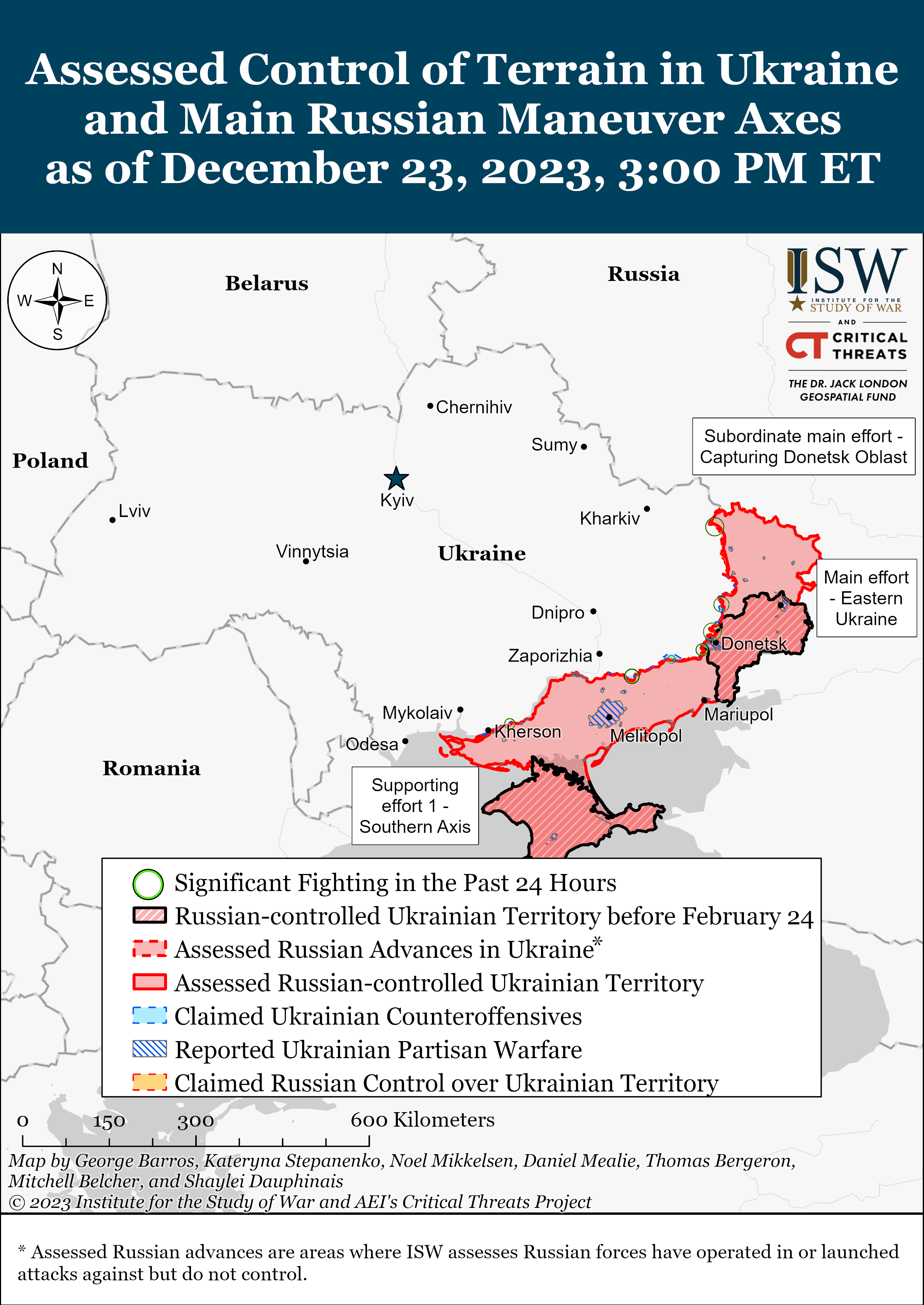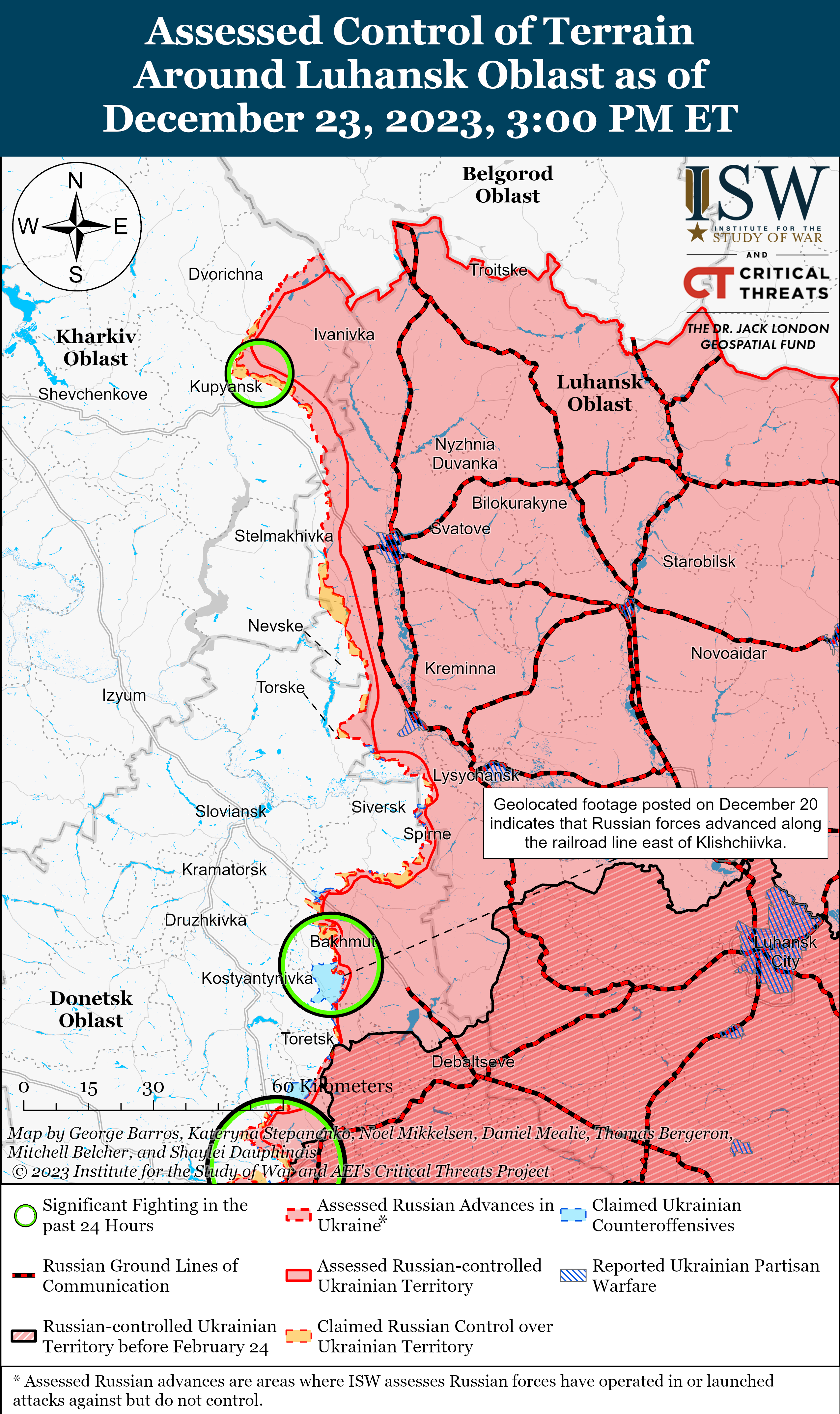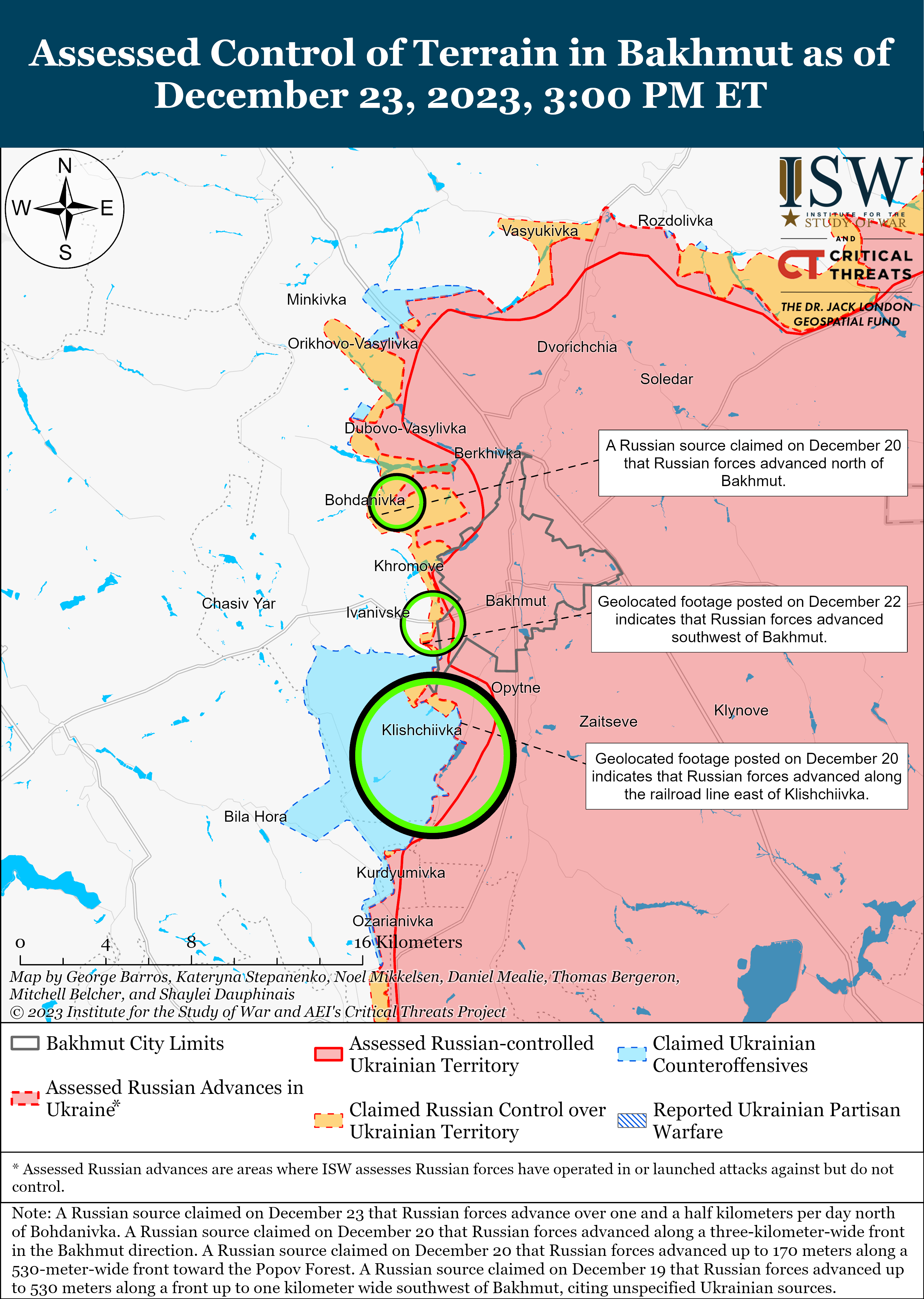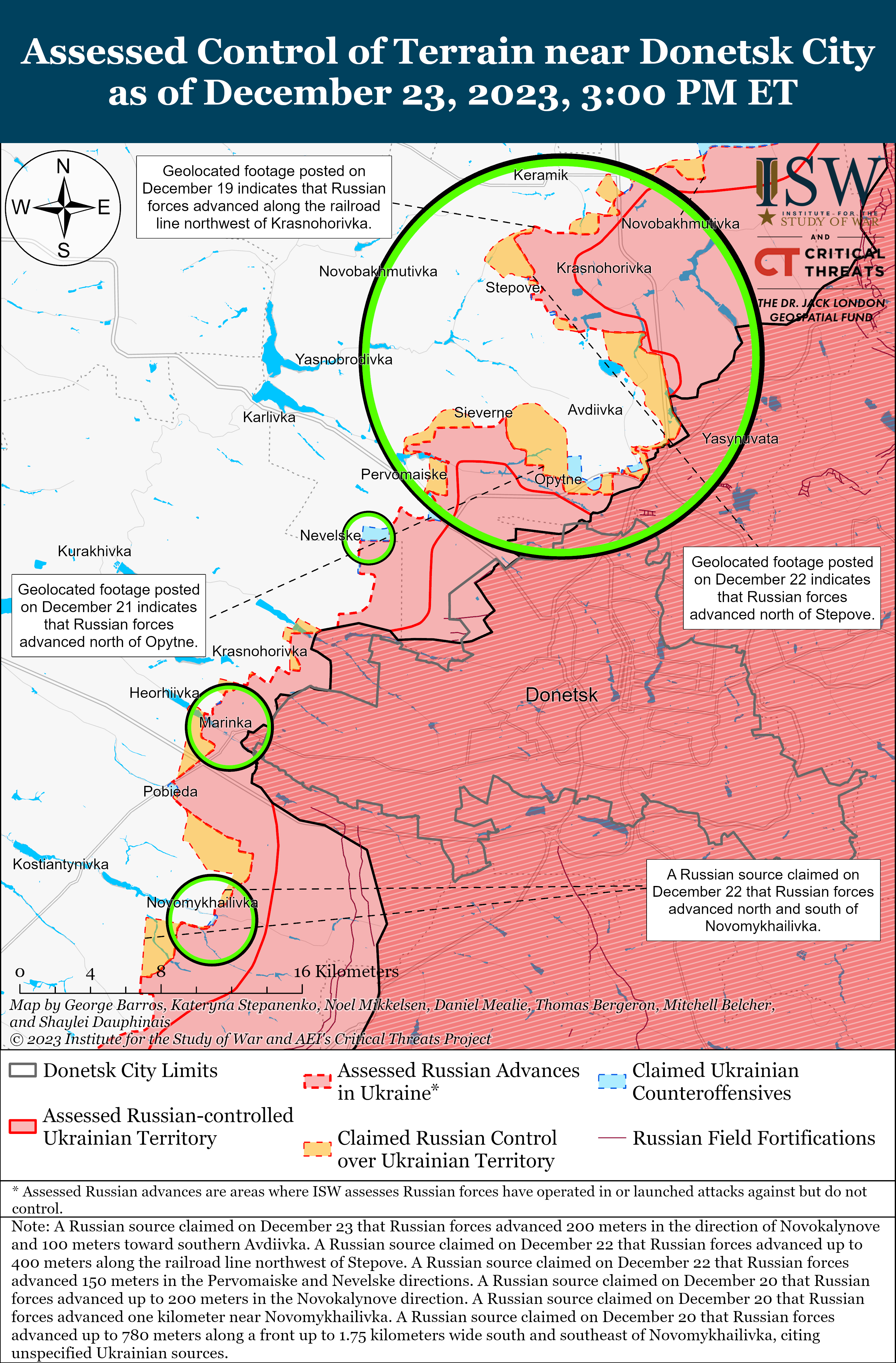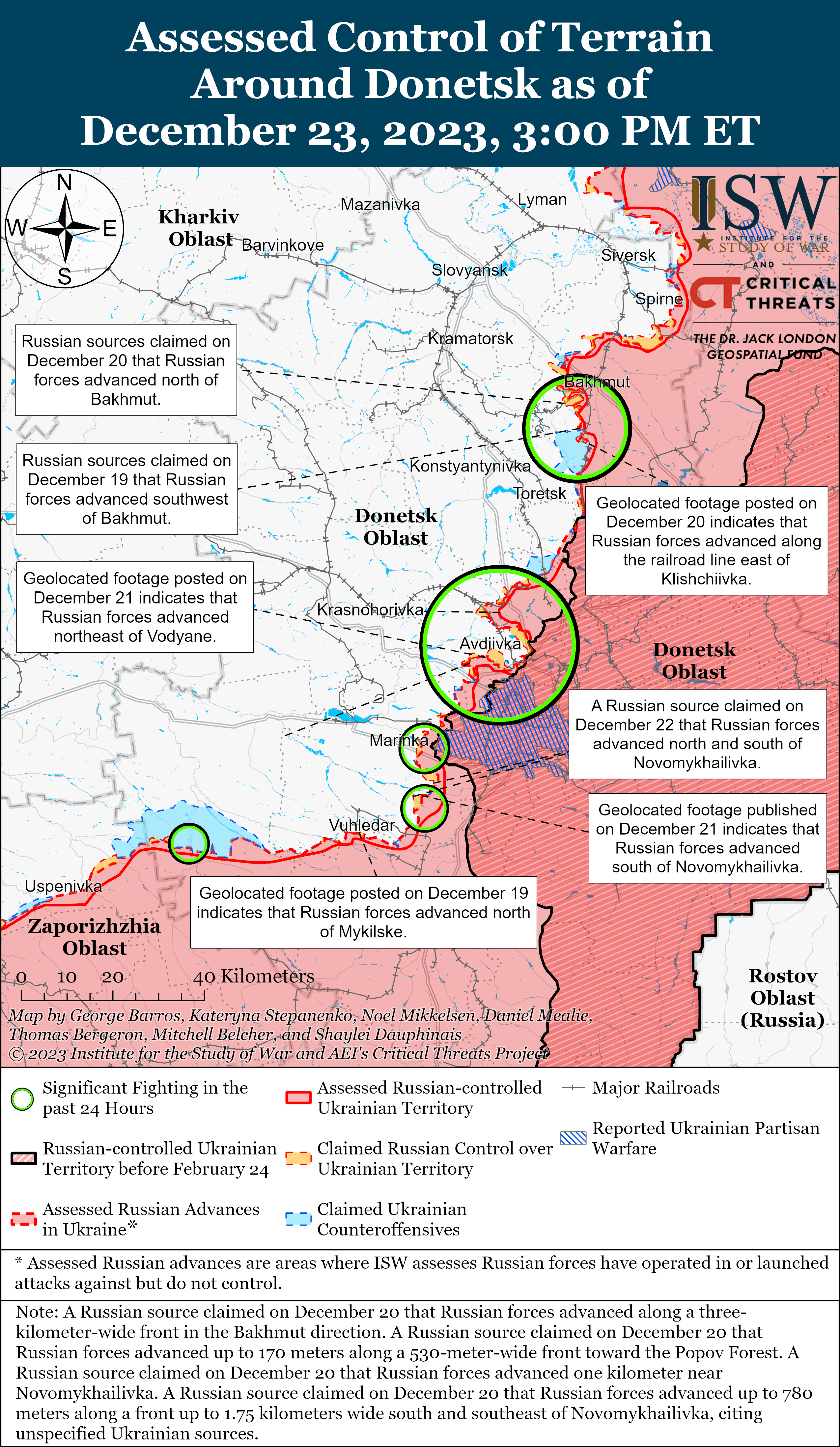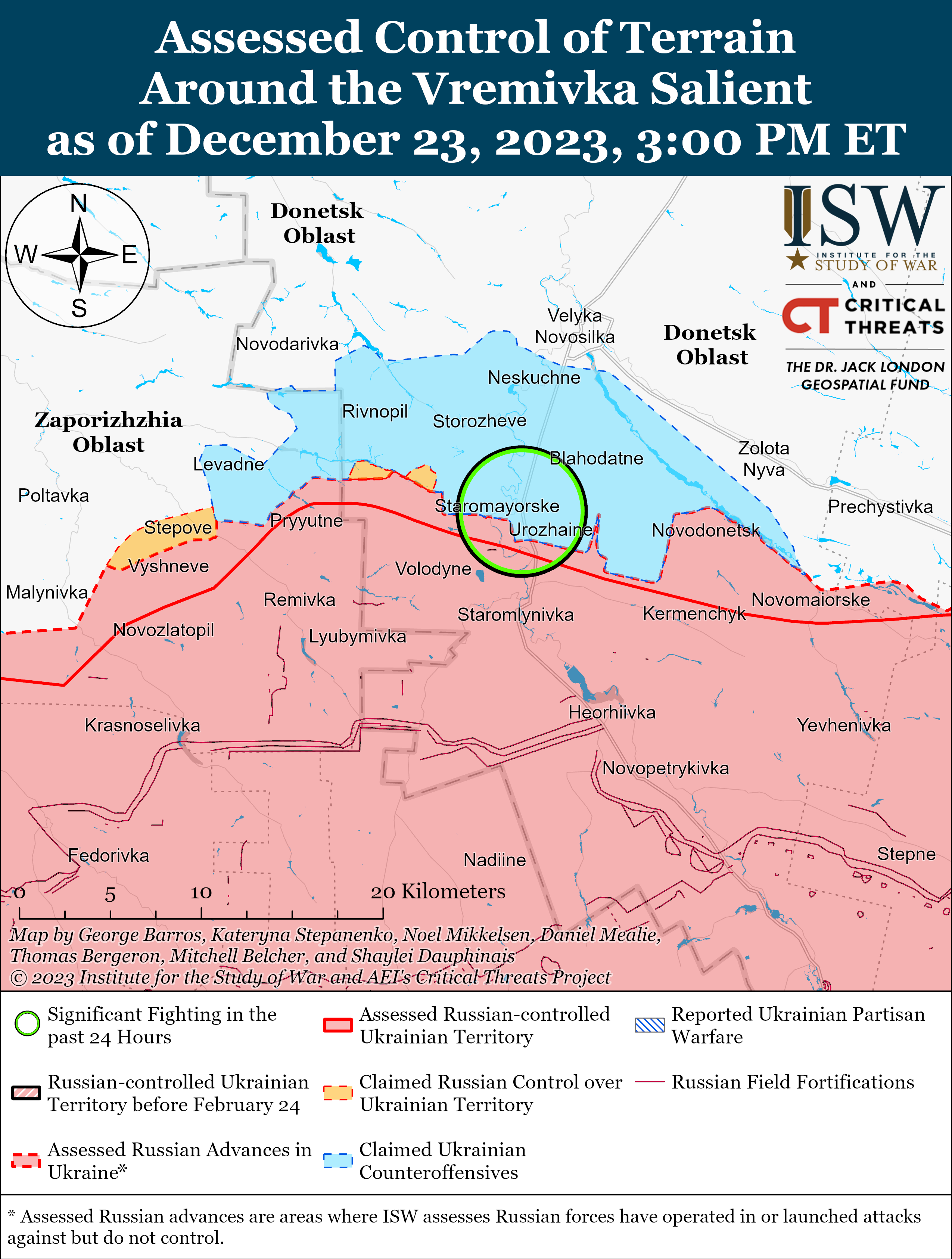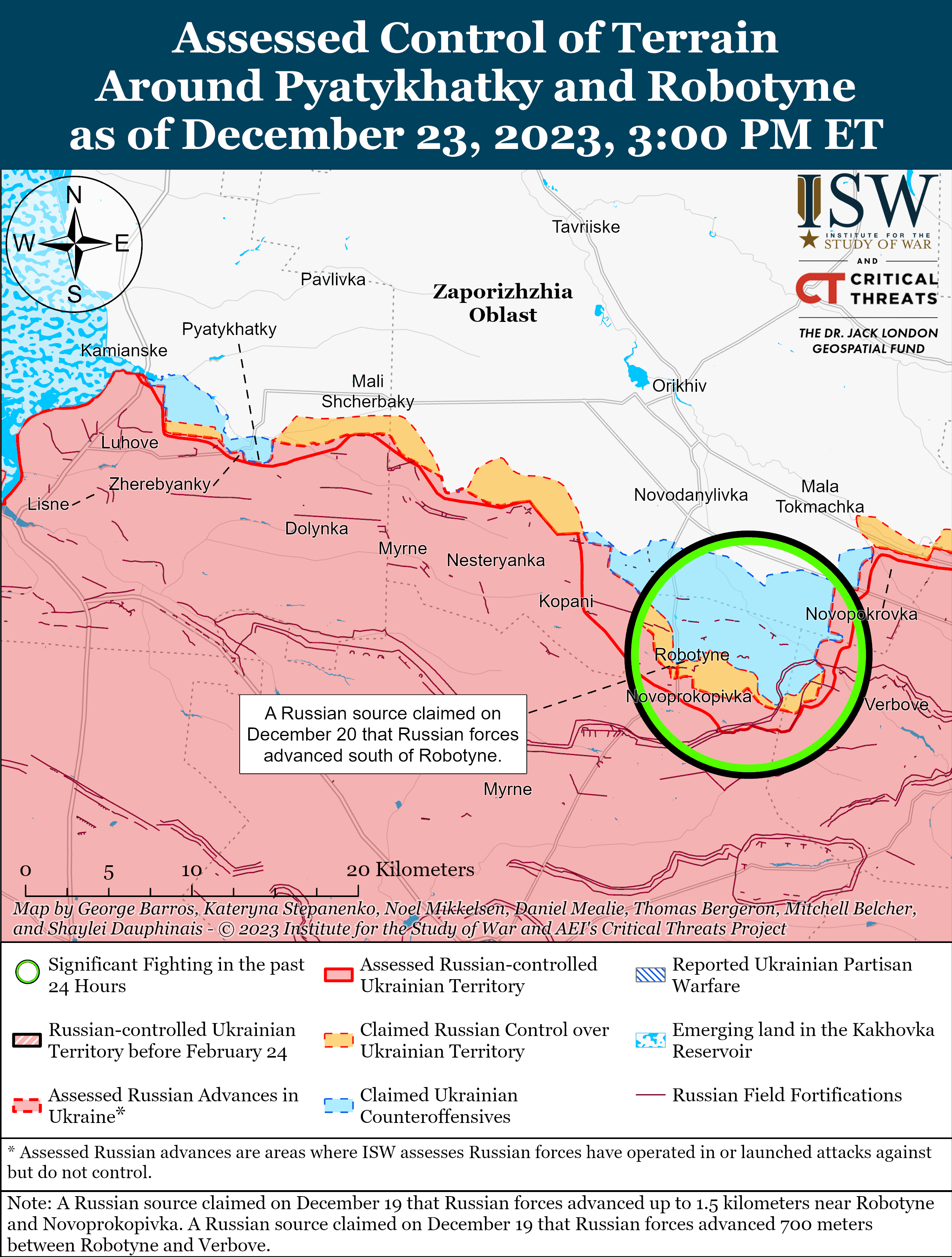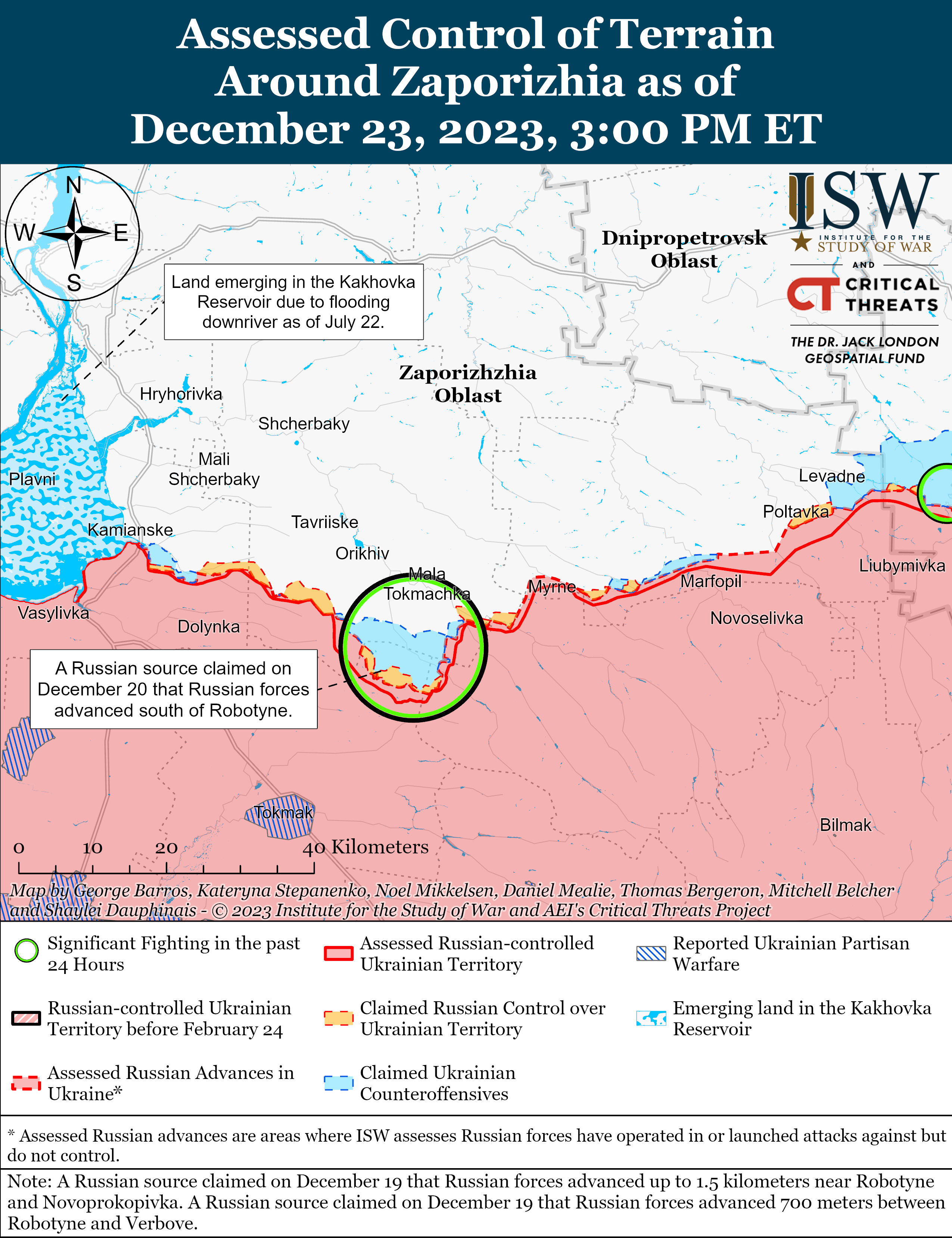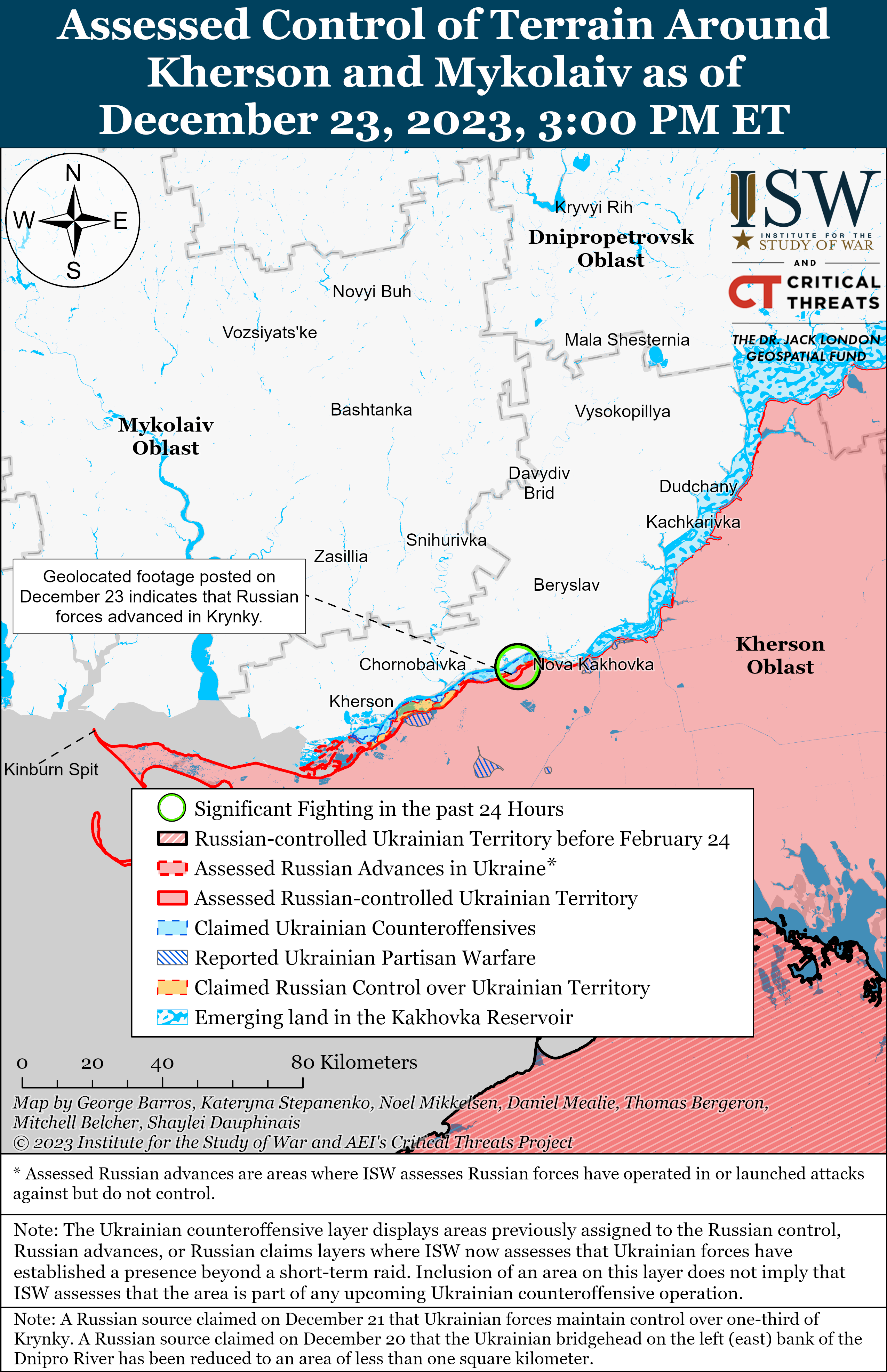Angelica Evans, Kateryna Stepanenko, Karolina Hird, Christina Harward, and Frederick W. Kagan
December 23, 2023, 8:30pm ET
Click here
to see ISW’s interactive map of the Russian invasion of Ukraine. This
map is updated daily alongside the static maps present in this report.
Click here
to see ISW’s 3D control of terrain topographic map of Ukraine. Use of a
computer (not a mobile device) is strongly recommended for using this
data-heavy tool.
Click here
to access ISW’s archive of interactive time-lapse maps of the Russian
invasion of Ukraine. These maps complement the static control-of-terrain
map that ISW produces daily by showing a dynamic frontline. ISW will
update this time-lapse map archive monthly.
Note:
The data cut-off for this product was 1:30pm ET on December 23. ISW
will cover subsequent reports in the December 24 Russian Offensive
Campaign Assessment.
The New York Times (NYT)
- citing former and current senior Russian, US, and international
officials - reported that Russian President Vladimir Putin is using back
channels and intermediaries to signal his interest in a ceasefire,
despite Putin’s recent public statements to the contrary.[1] NYT
reported that Western officials have been picking up renewed signals
through backchannels since September 2023 that Putin is interested in a
ceasefire that freezes the current frontlines, but noted that Western
officials warned the backchannels could be “Kremlin misdirection” and
may not reflect a “genuine willingness” to negotiate.[2] NYT
suggested several possible motivations Putin may have for his reported
interest in a ceasefire: the upcoming March 2024 Russian presidential
election, a desire to “keep his options open” regarding the war’s
resolution and take advantage of perceived waning Western support for
Ukraine, and the “distraction” of the Israel-Hamas war.[3]
All these motivations reflect temporary reasons why Putin might pursue a
temporary ceasefire that would benefit Russia by allowing Russia the
time to prepare for renewed aggression against Ukraine, as ISW has
routinely assessed. The NYT noted that Putin’s public
rhetoric, which has recently reasserted Russia’s maximalist objectives
that are tantamount to full Ukrainian and Western surrender, is at odds
with Putin’s reported private desire to “declare victory and move on.”[4] Neither the NYT
nor its sources offered any reason to believe Putin’s backchannel
communications would be more reflective of his goals than his public
speeches addressing domestic, Ukrainian, and international audiences.
The NYT report also failed to make clear whether Putin’s
alleged interest in a ceasefire is for a temporary pause or a permanent
end to the war.
Kremlin Spokesperson Dmitry Peskov told the NYT that
“Russia continues to be ready [for negotiations], but exclusively for
the achievement of its own goals” in response to a question about
Russia’s willingness to negotiate a ceasefire on the current lines.[5]
Putin has recently reiterated that his maximalist objectives in Ukraine
- “denazification,” “demilitarization,” and the imposition of a
“neutral status” on Ukraine - remain unchanged, and Putin and senior
Kremlin officials have increasingly expressed expansionist rhetoric
indicating that Putin’s objectives do not preclude further Russian
territorial conquests in Ukraine.[6]
The
timing of Putin’s reported interest in a ceasefire is more consistent
with Russia’s ongoing efforts to delay and discourage further Western
military assistance to Ukraine, than with a serious interest in ending
the war other than with a full Russian victory. ISW observed
similar Kremlin efforts to mislead Western policymakers into pressuring
Ukraine to negotiate with Russia in winter 2022-2023, and effectively
redirecting Western focus onto hypothetical negotiations rather than
ensuring that Ukraine has sufficient materiel before its spring-summer
counteroffensive.[7]
The Kremlin is likely using backchannels to achieve a similar effect
amidst Western debates for further military aid to Ukraine.
Russian
Airborne Forces (VDV) Commander Colonel General Mikhail Teplinsky
obliquely indicated that VDV forces are under significant pressure to
conduct rapid offensive operations near Bakhmut and repel Ukrainian
attacks on the east (left) bank of Kherson Oblast. Teplinsky
published a prerecorded commencement speech on December 23 to
congratulate the winter graduates of the Ryazan Higher Airborne Command
School in which he outlined the VDV’s involvement in ongoing combat
operations in Donetsk, Zaporizhia, and Kherson oblasts.[8]
Teplinsky claimed that VDV forces repelled the Ukrainian
counteroffensive in Zaporizhia Oblast throughout the summer and fall of
2023 and added that elements of the Russian 98th Guards VDV Division and
106th Guards VDV Divisions began offensive operations on the
Soledar-Bakhmut direction in November. Teplinsky carefully caveated his
discussion of VDV operations with the observation that the VDV is
deliberately maintaining a slow tempo of attacks in the Bakhmut
direction to avoid high casualty rates and to prioritize attriting
Ukrainian forces over pushing them out from their positions. Teplinsky’s
emphasis on slow advances may be an attempt to message to the highest
echelon of the Russian military command – such as Chief of the Russian
General Staff Army General Valery Gerasimov – that the command’s
expectations of rapid advances near Bakhmut are unrealistic without
significant VDV casualties and sacrifices. Teplinsky released a similar
video in February 2023 in which he condemned the higher military command
for committing VDV troops to senseless attacks to achieve minor
tactical gains at a high manpower cost, likely in reference to VDV
involvement in battles for Soledar in January 2023.[9]
Teplinsky
also stated that elements of the newly formed 104th VDV Division are
tirelessly fighting to repel Ukrainian forces from the east bank of the
Dnipro River in occupied Kherson Oblast, despite the fact that these
elements are not as combat effective as other (more experienced) VDV
forces. Teplinsky stated that despite the VDV’s efforts Ukrainian forces
are continuing to deploy additional reinforcements to the east bank but
claimed that Russia’s victory is only a matter of time. ISW observed
Russian President Vladimir Putin single out the tactical and operational
situation in Krynky on the east bank during his "Direct Line" forum on
December 14, which may have reflected Putin’s sensitivity to continued
Russian information space neuralgia about Russian operations in the
area.[10]
ISW assessed that Putin’s comment highlighting Russian forces’
inability to oust Ukrainian forces from the east bank was likely also a
critique of Teplinsky, whom he appointed to command Russian “Dnepr”
Grouping of Forces in late October 2023.[11]
Teplinsky has repeatedly weaponized the Russian information space to
his advantage and may have used this commencement speech to respond to
the pressure from the Russian military command and the Kremlin.[12]
Teplinsky specifically uses greeting videos addressed to Russian
military personnel to indirectly voice his problems with the Russian
military command, and the Russian Ministry of Defense (MoD) notably even
removed his August 2 VDV Day greeting after he revealed the total
number of VDV casualties since February 2022.[13]
Teplinsky may also be setting information conditions to retain support
from other commentators who have repeatedly voiced concern about
Russia’s inability to push Ukrainian forces to the west (right) bank of
the Dnipro River in Kherson Oblast.[14]
Teplinsky
also implied that the Russian military command is deploying new VDV
officers and troops promptly to the frontlines without having them
complete pre-combat training. Teplinsky stated that
“unfortunately” the April graduates of the Ryazan Higher Airborne
Command School deployed to combat zones before their intended
unspecified autumn deployment date. While Teplinsky did not specify why
the April graduates deployed significantly earlier than their slated
deployment date, it is likely that these VDV forces were meant to
undergo some advanced individual or unit-wide training over a six-month
period – a requirement that the Russian military command evidently
neglected. Teplinsky added that April graduates have already suffered
casualties on the frontlines in November in an unspecified direction.
Teplinsky stated that many of the December graduates will join the ranks
of the 104th VDV Division in the Kherson direction and noted that the
graduates have hard work ahead of them to “speed up” Ukraine’s defeat.
Teplinsky may have explicitly observed that the 104th VDV Division is
less combat effective to resurface the issue of the Russian command
sending recent graduates of military command schools to the frontlines.
ISW has long assessed that the Russian military command is committing
all available forces to immediately reinforce its war effort in Ukraine
at the expense of combat effectiveness and long-term capacity building,
and Teplinsky’s account further demonstrates that similar issues also
plague formerly elite forces such as the VDV.[15]
Russia's
Black Sea Fleet's 810th Naval Infantry Brigade confirmed that it is
deliberately using chemical weapons against Ukrainian forces in an
apparent violation of the Chemical Weapons Convention, to which Russia
is a party. The 810th Naval Infantry Brigade published a long
post to its Telegram channel on December 22 detailing a "radical change
in tactics" that the brigade is using against Ukrainian forces in Krynky
(on the eastern bank of Kherson Oblast).[16]
The post claimed that elements of the 810th Naval Infantry Brigade
rotated into the Krynky area and are applying the new tactic of
"dropping K-51 grenades from drones" onto Ukrainian positions to smoke
Ukrainian forces out of their positions and expose them to fire from
various arms.[17]
The 810th Naval Infantry Brigade additionally published footage that
apparently shows such a K-51 drop on a Ukrainian position, presumably in
Krynky.[18]
K-51 aerosol grenades are filled with irritant CS gas
(2-Chlorobenzalmalononitrile), a type of tear gas used for riot control
(also known as a Riot Control Agent [RCA]).[19]
The Chemical Weapons Convention (CWC) prohibits the use of RCAs as a
method of warfare, and Russia has been a state party to the CWC since
1997.[20] ISW previously observed that Russian forces used K-51 grenades against Ukrainian positions in Donetsk Oblast in November 2022.[21]
Russian forces conducted a series of Shahed-136/131 drone strikes against Ukraine on the night of December 22-23. Ukrainian
military officials reported that Russian forces launched nine Shahed
drones from Balaklava, occupied Crimea and Primorsko-Akhtarsk, Krasnodar
Krai on the night of December 22 to 23 and that Ukrainian forces shot
down all of the drones.[22]
Recent
analysis by OSINT analyst MT Anderson confirms that while Russian
forces have moved the bulk of Black Sea Fleet (BSF) assets away from
occupied Sevastopol, the BSF maintains a limited naval presence in
Sevastopol.[23] Anderson
posted high-resolution satellite imagery from December 20 showing that
two Bora-class corvettes, two Ropucha-class landing ships, one
Krivak-class frigate, and the Matros Koshka bulk carrier remain at the otherwise empty BSF frigate pier in southern Sevastopol.[24]
Anderson noted that it appears that Russian forces have rebuilt many of
the defenses at the entrance of Sevastopol Harbor following a powerful
Black Sea cyclone at the end of November.[25]
Anderson also posted satellite imagery of the BSF headquarters in
Sevastopol and noted that it does not appear to be undergoing
renovations following a massive Ukrainian strike on the headquarters on
September 22.[26]
The satellite imagery additionally shows that one Ropucha-class landing
ship, one Natya-class minesweeper, one Alexandrit-class minesweeper,
and the Ivan Khurs Ivanov-class intelligence ship remain at the pier at Pivdenna Bay, but that the submarine pen is empty.[27]
The satellite imagery confirms the absence of several major BSF naval
assets, including specialized Kalibr cruise missile carriers, from the
docks at Sevastopol, which supports ISW's assessment that Russia has
moved many major BSF assets out of Sevastopol to Novorossiysk on an
enduring basis.[28]
The
Russian information space exploited news of a Ukrainian journalist’s
decision not to return to Ukraine after an assignment abroad to amplify
ongoing Russian information operations about resistance to full
mobilization efforts in Ukraine that purposefully ignore the much more
substantial Russian resistance to Russia’s partial mobilization of
reservists in September 2022. Russian state media and
milbloggers amplified news that a Ukrainian television journalist
decided to stay in Brussels after covering the EU Summit there from
December 14 to 15.[29] Russian milbloggers claimed that the Ukrainian journalist stayed in Brussels to avoid mobilization.[30]
Russian outlets naturally did not mention that at least 700,000
Russians immediately left Russia when Russian President Vladimir Putin
announced the “partial mobilization” of 300,000 reservists on September
21, 2022.[31]
The unpopularity of Russia’s partial mobilization and ensuing mass
emigration led Russian authorities to engage in crypto-mobilization
efforts that continue today, including recruiting volunteers and
forcibly conscripting migrants and newly naturalized Russian citizens.[32]
Resistance to mobilization is to be expected in a protracted and bloody
war, and the disproportionate amplification of a singular prominent
Ukrainian citizen’s behavior is part of ongoing Russian information
operations that attempt to paint a picture of widespread resistance to
the full mobilization in Ukraine made necessary by Russia’s invasion.
Russian
milbloggers used the granting of Russian citizenship to Palestinian
refugees on December 23 to promote the idea of Russia’s “compatriots
abroad” - an oft-used Kremlin justification for its war in Ukraine. Dagestani
authorities granted 45 Palestinian refugees, including seven minors,
Russian citizenship on December 23, after the refugees reportedly
evacuated to Dagestan from Gaza.[33]
Select Russian milbloggers, including Kremlin-appointed Russian Human
Rights Council member Alexander “Sasha” Kots, expressed shock at the
speed and ease of the refugees’ citizenship process and called for
Russian authorities to apply this expedited citizenship process to the
whole country and to Russian “compatriots” abroad who are “risking
everything” to support Russia.[34]
The Kremlin has intentionally and broadly defined “compatriots” as
ethnic Russians and Russian speakers living in the Russian sphere of
influence, which is not limited to those with Russian citizenship or
residing in Russia.[35]
Russian President Vladimir Putin has recently renewed his rhetoric
about the concept of “compatriots abroad” when discussing Russia’s
"sovereignty,” the fiction of a “genocide in Donbas,” and Russia’s duty
to protect these “compatriots” as part of justifications for Russia’s
maximalist objectives in Ukraine.[36]
The fact that Kots, who is notably one of the “trusted persons” who can
campaign on Putin’s behalf, invoked the narrative about “compatriots
abroad” in connection with news about Palestinian refugees – as opposed
to other Kremlin narratives more directly related to the Israel-Hamas
war, such as Putin’s recent anti-Israel rhetoric - suggests that the
“compatriots abroad” narrative may be of particular importance to the
Kremlin, or is perceived as such at least by important voices in the
Russian information space.[37]
Select Russian information space actors may continue to seize on the
issue of Palestinian refugees in Russia to advocate for a more
maximalist and holistic approach to Putin's Russian World (Russkiy Mir)
ideology and the intensified integration of Russian “compatriots” into
the Russian world.
Key Takeaways:
- The New York Times (NYT) - citing former and current senior Russian, US, and international officials - reported that Russian President Vladimir Putin is using back channels and intermediaries to signal his interest in a ceasefire, despite Putin’s recent public statements to the contrary.
- The timing of Putin’s reported interest in a ceasefire is more consistent with Russia’s ongoing efforts to delay and discourage further Western military assistance to Ukraine, than with a serious interest in ending the war other than with a full Russian victory.
- Russian Airborne Forces (VDV) Commander Colonel General Mikhail Teplinsky obliquely indicated that VDV forces are under significant pressure to conduct rapid offensive operations near Bakhmut and repel Ukrainian attacks on the east (left) bank of Kherson Oblast.
- Teplinsky also implied that the Russian military command is deploying new VDV officers and troops promptly to the frontlines without having them complete pre-combat training.
- Russia's Black Sea Fleet's 810th Naval Infantry Brigade confirmed that it is deliberately using chemical weapons against Ukrainian forces in an apparent violation of the Chemical Weapons Convention, to which Russia is a party.
- Recent analysis by OSINT analyst MT Anderson confirms that while Russian forces have moved the bulk of Black Sea Fleet (BSF) assets away from occupied Sevastopol, the BSF maintains a limited naval presence in Sevastopol.
- The Russian information space exploited news of a Ukrainian journalist’s decision not to return to Ukraine after an assignment abroad to amplify ongoing Russian information operations about resistance to full mobilization efforts in Ukraine that purposefully ignore the much more substantial Russian resistance to Russia’s partial mobilization of reservists in September 2022.
- Russian milbloggers used the granting of Russian citizenship to Palestinian refugees on December 23 to promote the idea of Russia’s “compatriots abroad” - an oft-used Kremlin justification for its war in Ukraine.
- Russian forces made recent confirmed advances near Kupyansk and Kreminna, northeast of Bakhmut, southwest of Donetsk City, and in east (left) bank Kherson Oblast and continued positional engagements along the entire line of contact.
- Russian state-owned defense conglomerate Rostec subsidiary United Aircraft Corporation (UAC) Head Yuri Slyusar stated during a television interview on December 19 that UAC will increase its production of combat aircraft in 2024 and 2025, including its production of new types of aircraft.
- Russian occupation authorities are building out electoral infrastructure in occupied Ukraine to set conditions for the upcoming presidential election.
We
do not report in detail on Russian war crimes because these activities
are well-covered in Western media and do not directly affect the
military operations we are assessing and forecasting. We will continue
to evaluate and report on the effects of these criminal activities on
the Ukrainian military and the Ukrainian population and specifically on
combat in Ukrainian urban areas. We utterly condemn Russian violations
of the laws of armed conflict and the Geneva Conventions and crimes
against humanity even though we do not describe them in these reports.
- Russian Main Effort – Eastern Ukraine (comprised of two subordinate main efforts)
- Russian Subordinate Main Effort #1 – Capture the remainder of Luhansk Oblast and push westward into eastern Kharkiv Oblast and encircle northern Donetsk Oblast
- Russian Subordinate Main Effort #2 – Capture the entirety of Donetsk Oblast
- Russian Supporting Effort – Southern Axis
- Russian Mobilization and Force Generation Efforts
- Russian Technological Adaptations
- Activities in Russian-occupied areas
- Russian Information Operations and Narratives
NOTE:
ISW has restructured the operational kinetic axis sections of the daily
Russian Offensive Campaign Assessment to more accurately reflect the
positional nature of fighting on the battlefield. Operational kinetic
axis paragraphs will be shorter and more synthetic to convey the same
assessment in fewer words and not to overwhelm the reader with long
lists of settlement names. The level of detail included in the report
has not decreased. The report’s endnotes still contain the same level of
sourcing, and ISW encourages readers interested in tactical granular
details to read them. ISW will explicitly flag major operational
inflections in axis text as usual, so the lack of named settlements
should not be taken as an indication of gains or losses of territory or
changes in the frontline. ISW will lead operational axes with confirmed
map changes to accord with the daily map products produced by the
Geospatial Intelligence Team, supplemented by Ukrainian and Russian
claims, and will also list order of battle (ORBAT) details in each axis
section when available.
Russian Main Effort – Eastern Ukraine
Russian Subordinate Main Effort #1 – Luhansk Oblast
(Russian objective: Capture the remainder of Luhansk Oblast and push
westward into eastern Kharkiv Oblast and northern Donetsk Oblast)
Russian forces recently made confirmed advances near Kupyansk and Kreminna. Geolocated footage posted on December 23 indicates that Russian forces made marginal gains in northern Synkivka (northeast of Kupyansk) and south of Dibrova (southwest of Kreminna).[38] Russian and Ukrainian forces continued positional engagements in the Kupyansk direction near Synkiva, Lake Lyman (just northwest of Synkivka), and Ivanivka, and west of Kreminna near Zhytlivka, Terny, Torske, and the Serebryanske forest area.[39] Elements of the Russian 6th and 20th Combined Arms Armies (CAAs) (both of the Western Military District [WMD]) are operating in the Kupyansk and Kreminna directions, respectively.[40]
Russian Subordinate Main Effort #2 – Donetsk Oblast (Russian objective: Capture the entirety of Donetsk Oblast, the claimed territory of Russia’s proxies in Donbas)
Russian
forces recently marginally advanced northeast of Bakhmut. Geolocated
footage published on December 23 indicates that Russian forces advanced
southwest of Spirne.[41]
Russian forces reportedly advanced on Bakhmut’s northern, western, and southern flanks as of December 23, but there were no confirmed changes to the frontline in this area. Russian sources claimed on December 23 that Russian forces advanced northwest of Bakhmut near Khromove; west of Bakhmut near Ivanivske; and southwest of Bakhmut near Klishchiivka, although ISW has not yet observed visual evidence to verify these claims.[42] Russian sources claimed that Russian forces entered the outskirts of Bohdanivka (northwest of Bakhmut).[43] A Ukrainian source stated that Ukrainian forces withdrew from some positions near the railway near Klishchiivka.[44] Ukrainian and Russian sources stated that positional engagements occurred northwest; west; and southwest of Bakhmut near Andriivka.[45] Elements of the Russian 98th Airborne (VDV) Division reportedly continue to operate near Bakhmut.[46]
Russian forces reportedly advanced near Avdiivka as of December 23, but there were no confirmed changes to the frontline in this area. Russian sources claimed that Russian forces advanced northwest of Avdiivka near the Avdiivka Coke Plant and towards Ocheretyne; southwest of Avdivika from Vodyane and Optyne; and southeast of Avdiivka from the industrial zone, although ISW has not observed visual evidence to verify these claims.[47] A Russian milblogger claimed that Russian forces advanced 200 meters towards Novokalynove (northwest of Avdiivka).[48] Russian and Ukrainian sources stated that positional engagements occurred northwest of Avdiivka near Novobakhmutivka, Novokalynove, and Stepove and southwest of Avdiivka near Sieverne, Pervomaiske, and Nevelske.[49] Elements of the Russian 110th Motorized Rifle Brigade (1st Donetsk People’s Republic [DNR] Army Corps) are reportedly operating near Avdiivka.[50]
Russian forces recently made marginal advances southwest of Donetsk City. Geolocated footage published on December 22 indicates that Russian forces marginally advanced southeast of Novomykhailivka.[51] Russian milbloggers claimed that Russian forces advanced southeast of Marinka (on the western outskirts of Donetsk City) and near Pobieda (south of Marinka).[52] A Russian source claimed that elements of the Russian 255th Motorized Rifle Regiment (20th Motorized Rifle Division, 8th Combined Arms Army, Southern Military District) advanced west of Marinka.[53] Russian and Ukrainian forces stated that fighting also occurred near Mainka, Novomykhailivka, and Pobieda.[54]
Russian Supporting Effort – Southern Axis (Russian objective: Maintain frontline positions and secure rear areas against Ukrainian strikes)
Russian forces reportedly unsuccessfully attacked west of Staromayorske (south of Velyka Novosilka) on December 23, but there were no confirmed changes to the frontline in the Donetsk-Zaporizhia Oblast border area.[55] Elements of the Russian 143rd Motorized Rifle Regiment (127th Motorized Rifle Division, 5th Combined Arms Army [CAA], Eastern Military District [EMD]) are reportedly operating southwest of Velyka Novosilka near Pryyutne.[56]
Russian and Ukrainian forces continued positional engagements around Robotyne on December 23, but there were no confirmed changes to the frontline. Russian forces reportedly attacked along the Kopani-Robotyne-Novoprokopivka-Verbove line south and east of Robotyne, and also attacked near Novopokrovka (northeast of Robotyne).[57] A Russian milblogger also claimed that Ukrainian forces attacked Russian positions along the Robotyne-Verbove line.[58] Zaporizhia Oblast occupation official Vladimir Rogov amplified footage that shows a Russian serviceman walking through a muddy trench, suggesting that weather conditions in the area are still complicating maneuver.[59] Elements of the Russian 247th Guards Airborne (VDV) Regiment (7th Guards VDV Division) are reportedly continuing to operate near Verbove.[60] Ukrainian Melitopol Mayor Ivan Fedorov reported that Russian forces are continuing to fortify Tokmak and northwestern and southern Melitopol in occupied Zaporizhia Oblast.[61] Russian sources claimed that Ukrainian forces carried out a drone attack on Berdyansk on December 22 and struck a Tokmak administration building with HIMARS rockets.[62]
Russian forces recently marginally advanced on the east (left) bank of the Dnipro River in Kherson Oblast. Geolocated footage published on December 23 shows that Russian forces advanced in the western part of Krynky on the east bank.[63] A Russian milblogger claimed that elements of the Russian 810th Naval Infantry Brigade (Black Sea Fleet) captured some positions in the Krynky area.[64] Ukrainian forces maintained their positions around Krynky, where positional battles are ongoing.[65]
Russian Mobilization and Force Generation Efforts (Russian objective: Expand combat power without conducting general mobilization)
Russian
state-owned defense conglomerate Rostec subsidiary United Aircraft
Corporation (UAC) Head Yuri Slyusar stated during a television interview
on December 19 that the UAC will increase its production of combat
aircraft in 2024 and 2025, including its production of new types of
aircraft.[66]
Slyusar specifically highlighted the Su-57 aircraft as an example of
UAC’s improved aircraft and claimed that Russian forces are using Su-57s
in Ukraine.
Russian news outlet Zvezda reported
on December 22, citing an unnamed Russian commander, that Russian forces
are using a new type of 152-mm high-explosive fragmentation shells with
an increased firing range in Ukraine.[67] The serviceman claimed that the shells have a firing range of more than 30 kilometers.
Russian Technological Adaptations (Russian objective: Introduce technological innovations to optimize systems for use in Ukraine)
Russian
forces are reportedly developing protective measures against Ukrainian
naval drone strikes. A Russian milblogger claimed on December 23 that
Russian forces are using buoys to block the entrances to harbors, and
also flying various aircraft and helicopters, including radar-equipped
“Seagull” Be-12 aircraft to counter Ukrainian naval drone strikes.[68]
The milblogger claimed that Russian forces are also using
radio-electronic equipment to jam drones’ communications and are
launching VT-40 strike drones from small boats to destroy incoming
Ukrainian naval drones.[69]
Ukrainian naval drone strikes have previously damaged several Russian
ships in the Black Sea and Sevastopol Bay and Russian forces.[70]
Activities in Russian-occupied areas
(Russian objective: Consolidate administrative control of annexed
areas; forcibly integrate Ukrainian citizens into Russian sociocultural,
economic, military, and governance systems)
Russian
occupation authorities are building out electoral infrastructure in
occupied Ukraine to set conditions for the upcoming presidential
election. Russian sources reported on December 23 that election
headquarters began collecting signatures for Russian President Vladimir
Putin's nomination in occupied Crimea and Zaporizhia, Kherson, Donetsk,
and Luhansk oblasts.[71] Kremlin newswire TASS noted
that occupation authorities opened a signature collection point in
Henichesk, occupied Kherson Oblast, in a local market for the
"convenience" of residents, suggesting that occupation officials are
co-locating election infrastructure with basic service infrastructure to
coerce people into participating in electoral processes.[72]
Russian Information Operations and Narratives
Russian
officials are setting conditions to falsely claim that Ukrainian forces
are planning to launch combat flights from NATO airbases. Russian
Deputy Defense Minister Sergei Ryabkov claimed on December 22 that
Western officials are discussing allowing Ukraine to use NATO airfields
for combat operations since Ukrainian airfields are so damaged, and
warned that this decision would have “grave consequences.”[73]
Russian Foreign Minister Sergei Lavrov issued a thinly-veiled threat
towards NATO on December 18, claiming that Western discussions about
allowing Ukrainian forces to use NATO airfields are “dangerous
thoughts.”[74]
Western officials have repeatedly stated their intention to send F-16
aircraft to Ukraine, and there is no indication that Western officials
intend for Ukrainian forces to operate any aircraft from NATO airbases.[75]
Significant activity in Belarus
(Russian efforts to increase its military presence in Belarus and
further integrate Belarus into Russian-favorable frameworks and Wagner
Group activity in Belarus)
Nothing significant to report.
Note: ISW does not receive any classified material from any source, uses only publicly available information, and draws extensively on Russian, Ukrainian, and Western reporting and social media as well as commercially available satellite imagery and other geospatial data as the basis for these reports. References to all sources used are provided in the endnotes of each update.
[1] https://www.nytimes.com/2023/12/23/world/europe/putin-russia-ukraine-war-cease-fire.html?smid=nytcore-ios-share&referringSource=articleShare
[2] https://www.nytimes.com/2023/12/23/world/europe/putin-russia-ukraine-war-cease-fire.html?smid=nytcore-ios-share&referringSource=articleShare
[3] https://www.nytimes.com/2023/12/23/world/europe/putin-russia-ukraine-war-cease-fire.html?smid=nytcore-ios-share&referringSource=articleShare ; https://isw.pub/UkrWar121523 ; https://isw.pub/UkrWar112723 ; https://isw.pub/UkrWar081723
[4] https://www.nytimes.com/2023/12/23/world/europe/putin-russia-ukraine-war-cease-fire.html?smid=nytcore-ios-share&referringSource=articleShare ; https://isw.pub/UkrWar121923
[5] https://www.nytimes.com/2023/12/23/world/europe/putin-russia-ukraine-war-cease-fire.html?smid=nytcore-ios-share&referringSource=articleShare
[6] https://www.understandingwar.org/backgrounder/russian-offensive-campaign-assessment-december-14-2023 ; https://isw.pub/UkrWar121723 ; https://isw.pub/UkrWar121523 ; https://isw.pub/UkrWar121023
; https://isw.pub/UkrWar121323
[7] https://www.understandingwar.org/backgrounder/russian-offensive-campaign-assessment-february-12-2023
[8] https://t.me/NeoficialniyBeZsonoV/31776
[9] https://understandingwar.org/backgrounder/russian-offensive-campaign-assessment-april-30-2023
[10] https://understandingwar.org/backgrounder/russian-offensive-campaign-assessment-december-14-2023
[11] https://www.understandingwar.org/backgrounder/russian-offensive-campaign-assessment-october-29-2023
[12] https://understandingwar.org/backgrounder/russian-offensive-campaign-assessment-april-30-2023 ; https://www.understandingwar.org/backgrounder/russian-offensive-campaign-assessment-july-16-2023
[13] https://www.rferl.org/a/russia-airborne-forces-casualties-ukraine/32532550.html
[14] https://t.me/voenkorKotenok/51840 ; https://t.me/milinfolive/109580 ; https://t.me/dva_majors/29429 ; https://www.understandingwar.org/backgrounder/russian-offensive-campaign-assessment-november-21-2023 ; https://isw.pub/UkrWar111023 ; https://isw.pub/UkrWar111323 ; https://isw.pub/UkrWar112823 ; https://www.understandingwar.org/backgrounder/russian-offensive-campaign-assessment-december-14-2023
[15] https://www.understandingwar.org/backgrounder/russian-offensive-campaign-assessment-september-1-2023 ; https://www.understandingwar.org/backgrounder/russian-offensive-campaign-assessment-october-20-2023 ; https://isw.pub/UkrWar101423 ; https://isw.pub/UkrWar100623 ; https://isw.pub/UkrWar090123 ; https://isw.pub/UkrWar110323 ; https://isw.pub/UkrWar120523
[17] https://t.me/morpeh_810/2339
[18] https://t.me/morpeh_810/2340
[19] https://cat-uxo.com/explosive-hazards/grenades/k-51-hand-grenade; https://www.rusi.org/explore-our-research/publications/commentary/have-chemical-weapons-been-used-ukraine
[20] https://www.opcw.org/our-work/what-chemical-weapon#:~:text=Riot%20Control%20Agents%20(RCAs),time%20following%20termination%20or%20exposure. ; https://ihl-databases.icrc.org/en/customary-ihl/v1/rule75#Fn_B57A3C3D_00007; https://www.armscontrol.org/factsheets/cwcsig; https://www.rusi.org/explore-our-research/publications/commentary/have-chemical-weapons-been-used-ukraine
[21] https://www.understandingwar.org/backgrounder/russian-offensive-campaign-assessment-november-14
[22] https://www.facebook.com/GeneralStaff.ua/posts/pfbid0aG32uqgtsGmLL4KEKoZvp5jdkK2CSXwLXww7wLkp8MRPq7MSa1YVpeAviMZnJWMSl ; https://t.me/kpszsu/8796
[23] https://twitter.com/MT_Anderson/status/1738397253541191843
[24] https://twitter.com/MT_Anderson/status/1738397254891831310
[25] https://twitter.com/MT_Anderson/status/1738397258490458541
[26] https://www.understandingwar.org/backgrounder/russian-offensive-campaign-assessment-september-25-2023; https://twitter.com/MT_Anderson/status/1738397260554084567
[27] https://twitter.com/MT_Anderson/status/1738397262466682976; https://twitter.com/MT_Anderson/status/1738397264299573488
[28] https://www.understandingwar.org/backgrounder/ukrainian-strikes-have-changed-russian-naval-operations-black-sea
[29] https://t.me/tass_agency/223868 ; https://t.me/boris_rozhin/107186; https://t.me/miroshnik_r/13564 ; https://t.me/notes_veterans/14421 ; https://t.me/voenkorKotenok/52895; https://t.me/vrogov/13458
[30] https://t.me/vrogov/13458 ; https://t.me/miroshnik_r/13564 ; https://t.me/boris_rozhin/107186 ; https://t.me/voenkorKotenok/52895 ; https://t.me/notes_veterans/14421
[31] https://www.understandingwar.org/backgrounder/russian-offensive-campaign-assessment-september-21#:~:text=Russian%20President%20Vladimir%20Putin's%20announcement,resolve%20in%20the%20coming%20months. ; https://understandingwar.org/backgrounder/russian-offensive-campaign-assessment-september-28 ; https://www.understandingwar.org/backgrounder/russian-offensive-campaign-assessment-september-30 ; https://www.understandingwar.org/backgrounder/russian-offensive-campaign-assessment-october-28 ; https://www.understandingwar.org/backgrounder/russian-offensive-campaign-assessment-january-25-2023
[32] https://www.understandingwar.org/backgrounder/russian-offensive-campaign-assessment-december-20-2023 ; https://www.understandingwar.org/backgrounder/russian-offensive-campaign-assessment-december-3-2023 ; https://www.understandingwar.org/backgrounder/russian-offensive-campaign-assessment-november-11-2023 ; https://www.understandingwar.org/backgrounder/russian-offensive-campaign-assessment-september-3-2023
[33] https://ria dot ru/20231223/palestina-1917671253.html ; https://t.me/tass_agency/223927
[34] https://t.me/sashakots/44109 ; https://t.me/warhistoryalconafter/138482 ; https://t.me/NeoficialniyBeZsonoV/31789
[35] https://isw.pub/UkrWar121423 ; https://isw.pub/UkrWar121723
[36] https://isw.pub/UkrWar121423 ; https://isw.pub/UkrWar121723 ; https://isw.pub/UkrWar121923
[37] https://isw.pub/UkrWar122223 ; https://isw.pub/UkrWar121423 ; https://isw.pub/UkrWar121023 ; https://www.understandingwar.org/backgrounder/russian-offensive-campaign-assessment-november-22-2023 ; https://isw.pub/UkrWar121223
[38] * WARNING: GRAPHIC CONTENT * https://t.me/WarArchive_ua/8809; https://t.me/WarArchive_ua/8806; https://www.youtube.com/watch?v=0tgoy2OqGVc
[39] https://www.facebook.com/GeneralStaff.ua/posts/pfbid02wKzEWjoEeFpsshmCSWJSo82ojHk4Zn95Utv5PysJ42hwyrbjoemmaRoQQxEvy1vrl; https://www.facebook.com/GeneralStaff.ua/posts/pfbid02g9s14CkR5CAmmJh6poDeveqJZ7QVxNBqRVWniSqVJWCesGYz36GQySX6dbkEFmjGl; https://www.facebook.com/GeneralStaff.ua/posts/pfbid0yCYRcwdBCCLh7RU3gJrDtxvGjFLKTceWR7wPLVcqhdaX2nmFer8WPYPmYivhhGwtl; https://t.me/mod_russia/33901; https://t.me/mod_russia/33903 ; https://t.me/mod_russia/33912; https://t.me/mod_russia/33895
[40] https://t.me/mod_russia/33901; https://t.me/voenkorKotenok/52888
[41] https://t.me/WarArchive_ua/8800; https://t.me/ogshb8/276
[42] https://t.me/rybar/55278 ; https://t.me/dva_majors/31394 ; https://t.me/RVvoenkor/58821 ; https://t.me/RVvoenkor/58771 ; https://t.me/negumanitarnaya_pomosch_Z/13398 ; https://t.me/DnevnikDesantnika/5653 ; https://t.me/rezervsvo/41840 ; https://t.me/geromanat/16348 ; https://t.me/boris_rozhin/107142
[44] https://twitter.com/GirkinGirkin/status/1738521919270298071
[45] https://www.facebook.com/GeneralStaff.ua/posts/pfbid02wKzEWjoEeFpsshmCSWJSo82ojHk4Zn95Utv5PysJ42hwyrbjoemmaRoQQxEvy1vrl ; https://www.facebook.com/GeneralStaff.ua/posts/pfbid02g9s14CkR5CAmmJh6poDeveqJZ7QVxNBqRVWniSqVJWCesGYz36GQySX6dbkEFmjGl; https://www.facebook.com/GeneralStaff.ua/posts/pfbid0yCYRcwdBCCLh7RU3gJrDtxvGjFLKTceWR7wPLVcqhdaX2nmFer8WPYPmYivhhGwtl ; https://t.me/mod_russia/33903 ; https://t.me/mod_russia/33913 ; https://t.me/rybar/55278 ; https://t.me/dva_majors/31394 ; https://t.me/RVvoenkor/58771 ; https://t.me/wargonzo/17167; https://twitter.com/GirkinGirkin/status/1738521919270298071
[46] https://t.me/mod_russia/33894
[47] https://t.me/RVvoenkor/58798 ; https://t.me/wargonzo/17167
[48] https://t.me/RVvoenkor/58798
[49] https://www.facebook.com/GeneralStaff.ua/posts/pfbid02wKzEWjoEeFpsshmCSWJSo82ojHk4Zn95Utv5PysJ42hwyrbjoemmaRoQQxEvy1vrl ; https://www.facebook.com/GeneralStaff.ua/posts/pfbid02g9s14CkR5CAmmJh6poDeveqJZ7QVxNBqRVWniSqVJWCesGYz36GQySX6dbkEFmjGl; https://www.facebook.com/GeneralStaff.ua/posts/pfbid0yCYRcwdBCCLh7RU3gJrDtxvGjFLKTceWR7wPLVcqhdaX2nmFer8WPYPmYivhhGwtl ; https://t.me/RVvoenkor/58798 ; https://t.me/wargonzo/17167 ; https://t.me/batalyon15/3412
[50] https://t.me/RVvoenkor/58804
[51] https://x.com/GeoConfirmed/status/1738518793364672771?s=20; https://x.com/NOELreports/status/1738300743042412808?s=20
[52] https://t.me/rybar/55270 ; https://t.me/wargonzo/17167
[53] https://t.me/RVvoenkor/58833
[54] https://www.facebook.com/GeneralStaff.ua/posts/pfbid02wKzEWjoEeFpsshmCSWJSo82ojHk4Zn95Utv5PysJ42hwyrbjoemmaRoQQxEvy1vrl ; https://www.facebook.com/GeneralStaff.ua/posts/pfbid02g9s14CkR5CAmmJh6poDeveqJZ7QVxNBqRVWniSqVJWCesGYz36GQySX6dbkEFmjGl; https://www.facebook.com/GeneralStaff.ua/posts/pfbid0yCYRcwdBCCLh7RU3gJrDtxvGjFLKTceWR7wPLVcqhdaX2nmFer8WPYPmYivhhGwtl ; https://t.me/mod_russia/33903 ; https://t.me/mod_russia/33914 ; https://t.me/rybar/55270 ; https://t.me/wargonzo/17167
[55] https://www.facebook.com/GeneralStaff.ua/posts/pfbid02g9s14CkR5CAmmJh6poDeveqJZ7QVxNBqRVWniSqVJWCesGYz36GQySX6dbkEFmjGl; https://www.facebook.com/GeneralStaff.ua/posts/pfbid0yCYRcwdBCCLh7RU3gJrDtxvGjFLKTceWR7wPLVcqhdaX2nmFer8WPYPmYivhhGwtl; https://t.me/wargonzo/17167
[57] https://www.facebook.com/GeneralStaff.ua/posts/pfbid02wKzEWjoEeFpsshmCSWJSo82ojHk4Zn95Utv5PysJ42hwyrbjoemmaRoQQxEvy1vrl; https://www.facebook.com/GeneralStaff.ua/posts/pfbid02g9s14CkR5CAmmJh6poDeveqJZ7QVxNBqRVWniSqVJWCesGYz36GQySX6dbkEFmjGl; https://www.facebook.com/GeneralStaff.ua/posts/pfbid0yCYRcwdBCCLh7RU3gJrDtxvGjFLKTceWR7wPLVcqhdaX2nmFer8WPYPmYivhhGwtl; https://t.me/wargonzo/17167; https://t.me/RVvoenkor/58830;
[59] https://t.me/vrogov/13451
[61] https://t.me/ivan_fedorov_melitopol/4105
[62] https://t.me/DnevnikDesantnika/5659
[65] https://www.facebook.com/GeneralStaff.ua/posts/pfbid02wKzEWjoEeFpsshmCSWJSo82ojHk4Zn95Utv5PysJ42hwyrbjoemmaRoQQxEvy1vrl; https://www.facebook.com/GeneralStaff.ua/posts/pfbid02g9s14CkR5CAmmJh6poDeveqJZ7QVxNBqRVWniSqVJWCesGYz36GQySX6dbkEFmjGl; https://www.facebook.com/GeneralStaff.ua/posts/pfbid0yCYRcwdBCCLh7RU3gJrDtxvGjFLKTceWR7wPLVcqhdaX2nmFer8WPYPmYivhhGwtl; https://t.me/SJTF_Odes/4281; https://t.me/rybar/55270; https://t.me/rybar/55278 ; https://t.me/dva_majors/31394; https://t.me/negumanitarnaya_pomosch_Z/13412;
[66] https://tass dot ru/ekonomika/19583109
[67] https://tvzvezda dot ru/news/202312221135-uAR6x.html ;https://t.me/boris_rozhin/107172
[70] https://isw.pub/UkrWar091623 ; https://isw.pub/UkrWar091523 ; https://isw.pub/UkrWar081823 ; https://isw.pub/UkrWar080523
[71] https://t.me/tass_agency/223898; https://t.me/tass_agency/223879; https://t.me/tass_agency/223851; https://t.me/sons_fatherland/11782; https://t.me/razvozhaev/4985; https://t.me/pushilindenis/4110
[73] https://www.interfax dot ru/interview/937457; https://meduza dot io/news/2023/12/22/mid-rf-zayavil-chto-ne-derzhitsya-obeimi-rukami-za-diplomaticheskie-otnosheniya-s-ssha
[74] https://www.understandingwar.org/backgrounder/russian-offensive-campaign-assessment-december-18-2023

